RADIOCARBON DATING OF LATE MEDIEVAL ELM TIMBERS
INTRODUCTION
The ability to precisely date a building structure is often the aspiration of building and architectural historians. Generally however researchers can only suggest a possible date range based on the similarity of features from buildings whose construction dates are known from documentary sources. The emergence of dendrochronology, initially as a means of correlating astronomical occurrences with climatic changes, developed steadily from the early 20 th century into a refined dating technique, offering the prospect of a precise date, even as to winter or summer, of the year in which a tree was felled. For building researchers this meant that, for the first time, roof structures, even down to the thatching laths, could be dated with precision; framing posts, beams, joists and panelling could be dealt with by the same method.PREVIOUS DATING PROGRAMME
Between 1996 and 2004 the Somerset Vernacular Building Research Group (SVBRG) obtained dates for fifty-three roof structures in a dendrochronology research programme to classify the development and use of differing forms of roof construction [1]. Roofs that had been constructed in oak were selected for examination because the standards compiled by and available to the dendrochronology laboratories, nationally and internationally, are for oak. However, not every sample of oak will provide a growth sequence that can be matched to the standards. Fast-grown oak often does not provide the fifty or so rings necessary for reliable correlation, nevertheless the programme was able to establish dates for just over two-thirds of the houses/structures examined.CONSTRUCTIONAL TIMBER IN SOMERSET
Oak was used extensively for roofs, doorways, doors, beams and partitions found in many of the older houses in the County in the earlier and higher status houses. Medieval court records at Winscombe reveal that oak was used for repairs to the manor house and its farm buildings. The records also reveal it was given to selected tenants to repair their houses [2]. However, our experience is that elm was much more common as the constructional timber in houses ranging from fairly high status to small cottages between the late medieval ages to the late 18 th century. Indeed, the abundance of elm in the countryside is remarked on by John Leland in the mid 16 th century; John Billingsley makes a similar observation in 1794.The Group’s study of houses in Winscombe & Sandford parish revealed that only two out of a sample of sixty houses had oak roofs. Elm predominated in the older houses and was gradually superseded during the 19 th century by softwoods.

THE M-TYPE APEX
During the study in Winscombe & Sandford a small number of roofs with a principal truss apex classified as ‘type M’ were found. This apex type had been identified in an exposition on cruck construction by N.W.Alcock in 1981 [3]. In his text he says, “At the very end of editing, type M was noted, a rare local variant from Somerset”.In the definition he describes the apex thus: M – Blades (of the cruck) meet on vertical line below threaded ridge, diagonal above. Several houses with M-apexes had been included in the 1996 Dendrochronology Programme and gave dates between 1342 and 1439.Two houses in Sandford had M-type apices and in both houses the roof structure was smoke-blackened, indicating that both were built as open-hall houses. The roof trusses were closed collar trusses with cambered collars set in the upper section of what were probably jointed crucks, although the joints had been lost or encased during repair or refurbishment of the houses. The remainder of an almost identical truss was found at Barton in the south west of the parish but in this instance the roof was not smoke- blackened.
A date for this apex type would not only help date the houses but would indicate the transition period from open-hall to chimneyed houses in this locality. The only way in which these elm roofs might be dated would be by the use of radiocarbon dating, a technique that would provide a statistically-based date range rather than the potentially more precise date obtainable from dendrochronology.
RADIOCARBON DATING
The principles behind radiocarbon dating are fairly straightforward but the science involved in understanding and correcting the variations is extremely complex as is the process of standardising the statistics that lie behind the final result. The following section attempts to provide a suitably simplified account of the method.The process by which radiocarbon dating is possible starts with cosmic rays from the sun colliding with atoms in the atmosphere. These collisions produce free neutrons which, if they collide with a nitrogen atom in the air, create an unstable carbon isotope, C 14 . Carbon dioxide (CO 2 ) in the air contains molecules with normal C 12 atoms and a small proportion of molecules with C 14 atoms. The latter are radioactive and hence will decay, reducing their number to half the current level in about 5700 years, (i.e. the isotope has a half life of 5700 years). Plants continuously absorb atmospheric CO 2 and thus always contain a small amount of C 14 that is continuously increased by “new” C 14 as the plant continues to grow. The natural ratio of C 12 to C 14 is nearly constant in the air and in all living organisms but when the organism dies it ceases to absorb any more C 14 . From knowing the half-life of C 14 and measuring the ratio of the two isotopes (i.e. C 14 : C 12 ) in a sample, it is possible to calculate when the ratio was at its natural value and hence to date the death of the organism.
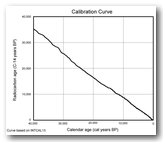
The currently favoured analytical method for establishing the isotope ratio is AMS (accelerator mass spectrometry) which counts the number of C 12 and C 14 atoms from the sample; the method is faster and utilises smaller sample weights than the alternative LSC (liquid scintillation counting) method. The “nearly constant” isotope ratio on which the method is based has been found to be variable over time and by location. Natural events such as the absorption of CO 2 into the oceans and volcanic activity cause variations, the burning of fossil fuels releases “old” carbon at later dates. Solar activity and atomic explosions similarly alter the natural ratio. The processing of analytical output data is complex and seeks to compensate for the variability. The result is described as the Radiocarbon Age or Age BP (Before Present) and is usually given as a date range representing one standard deviation from the average of the data processed by the analyser. To convert this result to Calendar Years the Radiocarbon Age is modified by way of a calibration curve that compares radiocarbon dates with those derived from dendrochronolgy. Dendrochronology sequences that go back some 14,000 years have been established through studies of long-lived trees such as bristlecone pine and trees preserved in peat bogs. Earlier C 14 data comes from plant macrofossils, speleothems and corals.
The departure from an idealised linear correlation of radiocarbon age to calendar age is comparatively small and in practical terms is relatively insignificant when analysing material that is thousands of years old [4].
In material from the medieval period the discrepancies, caused by the sum of natural variables and human activity can be such as to render the result almost meaningless as the calibration curve in Fig. 3 shows. Some of the uncertainty in the study of timber can be overcome by taking a sequence of samples with known date intervals between them, as determined by counting annual growth rings. The results from several locations in the sample are analysed using Bayesian statistical methods to reduce the uncertainty in the final result, a method known as “wiggle- matching”, [5] for which dedicated calibration programmes have been devised which are used throughout the profession.
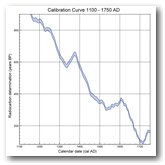
The dating of a tree by either dendrochronology or radiocarbon methods is usually given as that of the last growth ring at the heartwood-sapwood boundary. A limited amount of research, principally on oak, enables sapwood growth to be included in the wiggle- matching process which in turn enables an estimation for the felling date of the tree.
THE SVBRG RADIOCARBON DATING PROGRAMME
As this programme was exploratory it was limited to samples from three houses, sufficient to obtain useful information at an affordable cost. It was important to include Orchard Cottage and Laurel Farm as these represented the smoke-blackened and clean versions of the roof with the M apex. Another house Hale Farm was included because its construction confirmed it as an open-hall house which, although the roof had been replaced, had original timbers in the ceiling of the inner room that could be sampled. To provide enough material for possible wiggle-matching it was necessary to extract a sample from the timbers that had the greatest number of growth rings and to include the heartwood/sapwood interface if the bark surface was absent; the simplest means of ensuring this was to have a conventional ‘dendro-core’ removed by a dendro-chronologist.Analysis, Phase 1
A slice from each core representing the outer rings of the timber were sent for analysis to establish whether further sub-samples would be needed for wiggle-matching. The result from Hale Farm fell in a fairly straight part of the calibration curve (Fig. 4). The other two results (Figs. 5 and 6) were in more complex areas and would need wiggle-matching to provide a more reliable result.Analysis, Phase 2
To proceed further the cores were examined to establish the number of growth rings. In the event it was found that the cores from Orchard Cottage had thirty-one rings and Laurel Farm had slightly fewer. The laboratory advised concentrating on Orchard Cottage and accordingly sub-samples from rings 1-3 and rings 14-19 were selected.The reported results after the Bayesian analysis gave the dates of the outer rings, which were at the heartwood/sapwood boundary, as 1400-1420 AD at 63% probability. The incorporation of a correction for sapwood, based on English oak data, indicates a felling date of 1405-1460 at 77% probability.
Appraisal of results
Based on the results from Orchard Cottage and Hale Farm it was possible to make a visual appraisal of the Laurel Farm result and to estimate the felling-date ranges for the three houses.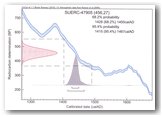
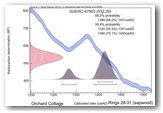
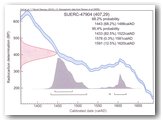
RESULTS
The results are given in the table below and are listed in date-range order. The dates put Orchard Cottage as the earliest of the houses studied here with a date range that is consistent with the presumed jointed cruck construction of the house. The date for Hale Farm consolidates our knowledge that in this locality open-hall houses were being built into the middle of the 15 th century. In this particular house it also confirms that two-centred arch-headed timber doorways were still in vogue. The slightly later date for the truss at Laurel Farm revealed that not only is a new house being erected in the parish using the same roof construction but that it is built with a chimney. Unfortunately this portion of a truss is all that is left of the original roof.| HOUSE | SAMPLE TAKEN FROM | FELLING DATE RANGE |
| Orchard Cottage | North principal rafter | 1405-1460 AD (reported) |
| Hale Farm | Inner room ceiling joist | 1445-1485 AD (est’d) |
| Laurel Farm | South principal rafter | 1480-1510 AD (est’d) |
CONCLUSIONS
The Method.
This programme has demonstrated the applicability of radiocarbon dating to elm timbers in medieval houses. It can be a substitute for oak dendrochronology where an oak sample is otherwise judged unsuitable. The use of standard extracted ‘dendro cores’ makes further analysis by ‘wiggle-matching’ a simple extension to the process.The method is intrinsically expensive but will consistently give a date range for the sample.
The Houses.
Through the use of radiocarbon dating the Group has established a threshold date for the transition to chimneyed houses in the parish and confirmation that open-hall houses were still being constructed in the middle of the 15 th century.The M-apex.
This exercise has shown that carpentry traditions are long-lived and do not necessarily change when the type of house changes. In this exercise dates of 1405-1460 and 1480-1510 have been deduced for this form of apex. M-apex. This exercise has shown that carpentry traditions are long-lived and do not necessarily change when the type of house changes. In this exercise dates of 1405-1460 and 1480-1510 have been deduced for this form of apex.ACKNOWLEDGEMENTS.
We acknowledge with thanks the financial support for the second phase of the programme from the Maltwood FundREFERENCES
- McDermott M. (2006) The Somerset Dendrochronology Project, Summary of Results, Vernacular Architecture, Vol. 37, 71-83
- SVBRG (2014), Traditional Houses in the parish of Winscombe and Sandford. ISBN 978-0-9523824-7-8
- Alcock N.W. (1981) Cruck construction. An introduction and catalogue. CBA Research Report No 42
- Internet Websites. Wikipedia, Oxford University, How stuff works.
- Bayliss A. (2007) Bayesian buildings; an introduction for the numerically challenged. Vernacular Architecture, Vol. 38 ,75-86
This article was originally published in Proceedings of SANHS, Vol. 158, p 120. 2015